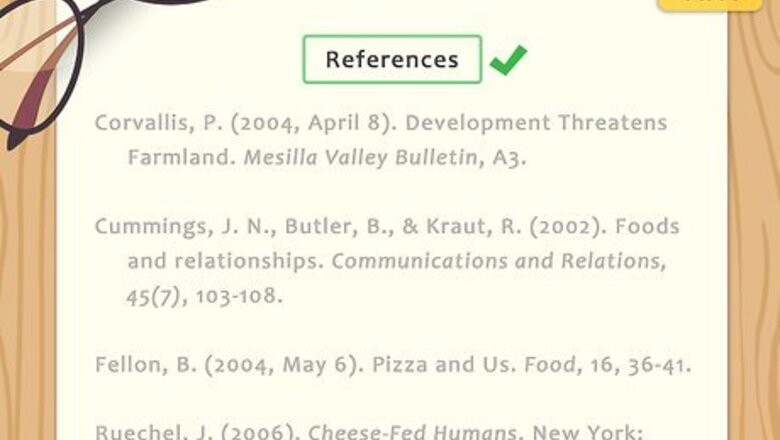
views
Writing an APA Bibliography
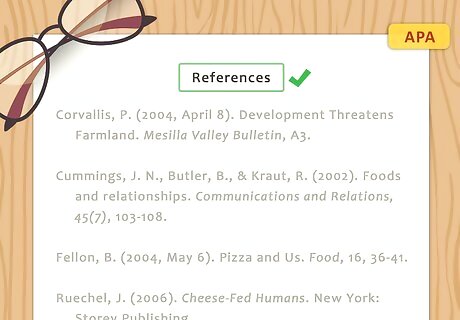
Create a reference list. Reserve a page at the end of the paper for the bibliography. Title it "References." Under this heading, you’ll list everything you’ve used in the paper.
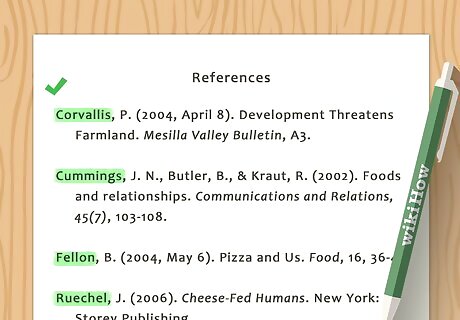
Sort all of your references alphabetically by last name. You should use the author’s full last name and then their first and middle (if available) initials. If there is more than one author, list the authors in the order they appear on the source, alphabetizing the source in your reference list by the first author’s last name. For example, if the author's name for a source is "John Adams Smith," you would list him as "Smith, J.A.," before listing the title of his piece.
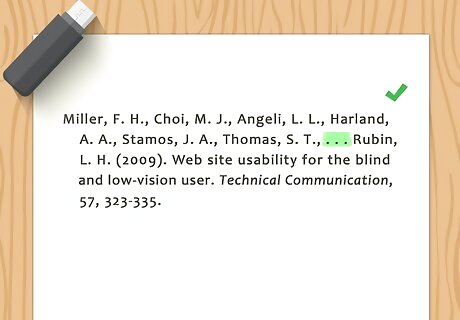
Use ellipses if there are more than seven authors. List the first seven authors of the source, and then use an ellipses (a series of three periods). After the ellipses, write the name of the last author listed on the source. For example, if one source has twelve authors, and the seventh author is "Smith, J.A." and the twelfth is "Timothy, S.J.," you would list the first six authors, then write "Smith, J.A. ...Timothy, S.J."
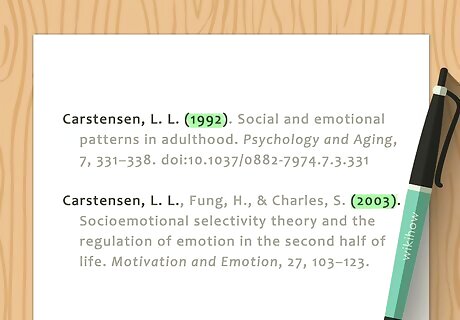
List sources by the same author is chronological order. Depending on the type of paper you’re writing, you might have multiple sources by the same author. Start with the source published first and list the rest of the sources chronologically.
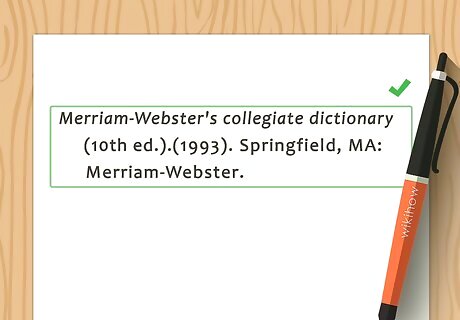
Use the information you have if you don’t have an author. Sometimes a source might be published by an organization, like the American Medical Association, or it might not have an author at all. If an organization is the author, write out the name of the organization. If there’s no author, begin with the title of the source. For example, if you have a World Health Organization Report without an author as one of your sources, you would write, "World Health Organization, "Report on Development Strategies in Developing Nations," July 1996."
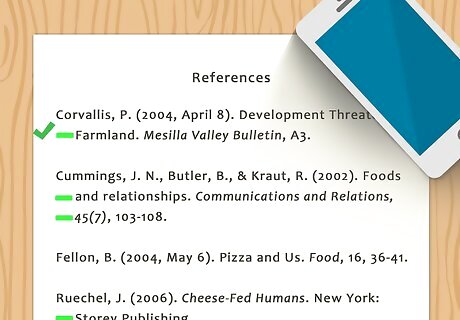
Indent each line after the first line of each source. If your source takes up more than one line, you’ll need to indent each succeeding line 0.5 inches (1.25 cm). When you move to the next source, start at the original margin of the paper.
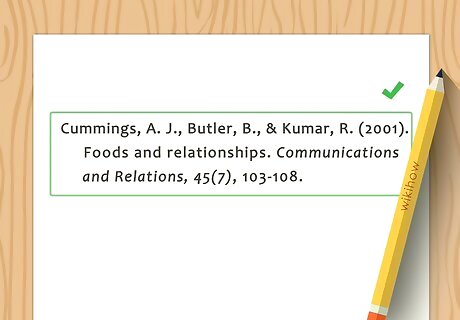
Cite articles. Articles are cited with the author's name, followed by the year, then the title of the article, the name of the publication in italics, the volume and issue number (if available), and the group of pages referenced. The format is as follows: Author, A. A., & Author, B. B. (Year). "Title of article." Title of Journal, volume number(issue number), pages. For example, an article citation might look like this: Jensen, O. E. (2012). "African Elephants." Savannah Quarterly, 2(1), 88. If the periodical the article comes from always begins with page number 1 (these types of periodicals are called “paginated by issue” periodicals, you should include the full page range of the article. If the article was retrieved online, end the citation with the words "Retrieved from" followed by the web address.
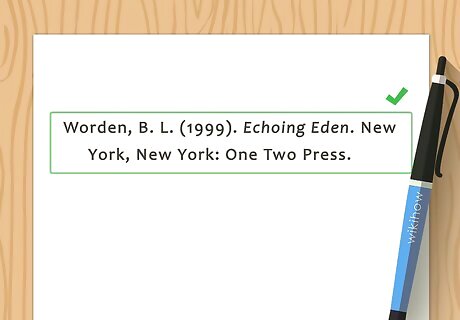
Cite books. Start with the author's name, followed by the publication year, the title of the book in italics, the location of the publisher, and finally the name of the publisher. The format is as follows: Author, A. A. (Year). Title of book. Location: Publisher. Example: Worden, B. L. (1999). Echoing Eden. New York, New York: One Two Press. If the title is more than one word long and doesn’t contain any proper nouns, only the first word should be capitalized. Only the first letter of any subtitle should be capitalized as well.
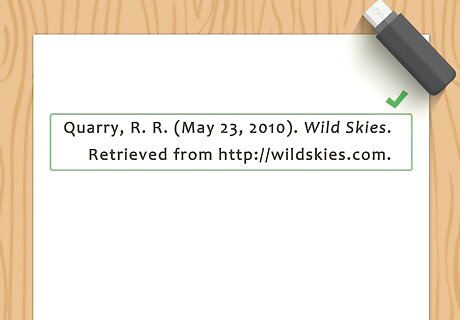
Cite websites. Include the author's name, the complete date, the title of the web page, and the words "retrieved from" followed by the web address. The format is as follows: Author, A. A. (Year, Month day). Title of web page/document. Retrieved from https://URL to specific page. For example, a cited website might look like this: Quarry, R. R. (May 23, 2010). Wild Skies. Retrieved from https://wildskies.com. If no author is available, just start with the title. If no date is available, write "n.d."

Check a reliable source for other citation rules. APA has a lot of rules for citing sources in your reference list. If you’re working with things like movies, dissertations, online periodicals, or other sources, use a reliable source. Purdue University’s OWL (Online Writing Lab) website is a great resource.
Writing a MLA Bibliography
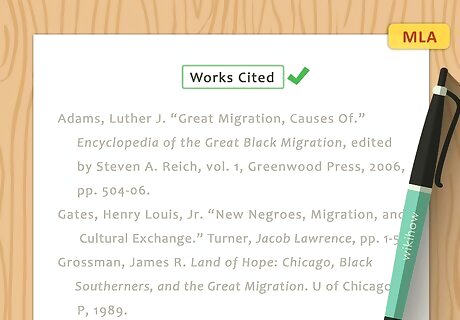
Create a works cited page. Reserve a page at the end of your paper for the bibliography, referred to as "works cited" in MLA style. Write "Works Cited" at the top of the next page after the last page of your paper. This page should have the same header with your last name as the rest of your paper, and your page numbers should continue onto this page, too.

Capitalize all words in titles except articles, prepositions, and conjunctions. You should capitalize every word in the title of your sources, except for words like “an,” “the,” and “of.” If you’re unsure how to capitalize your title, you can use online capitalization generators, like Title Capitalization, to check your titles.
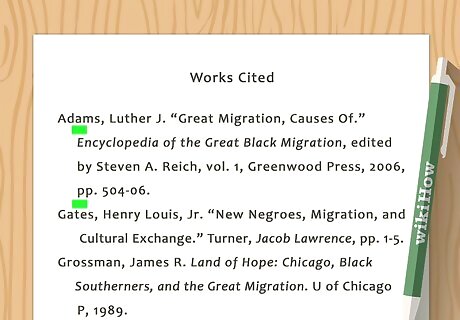
Double space your citations page. All of the pages of your MLA bibliography should be double spaced. You don’t need to put extra spaces between each source, as long as everything is double-spaced.
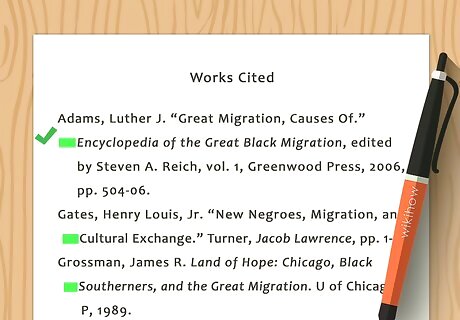
Indent each successive line for the same source. If your source takes up more than one line, indent the each successive line 0.5 inches (1.25 cm). Once you begin a new source, go back to the original margin.
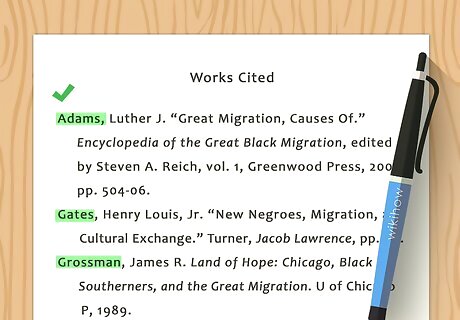
List your sources alphabetically by author’s last name. After the author’s last name, you should list their full first name and their middle name or initial, if they have one listed on the source. You shouldn’t use an author’s title or degrees when listing their names in your bibliography. This is true even if they are listed that way on the source.
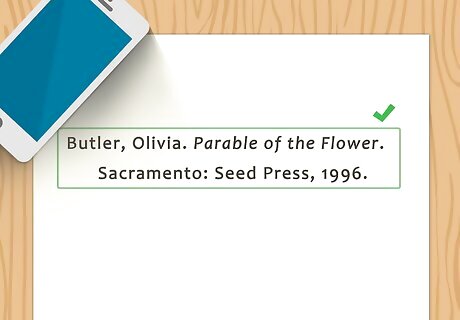
Cite books. Include the author's last name and first name, separated by a comma and ending with a period. Then the book title comes in italics with a period at the end of the title. The place of publication and the name of the publishing company are separated by a colon, and then a comma and the publication date. For example, a book citation might look like this: Butler, Olivia. Parable of the Flower. Sacramento: Seed Press, 1996.
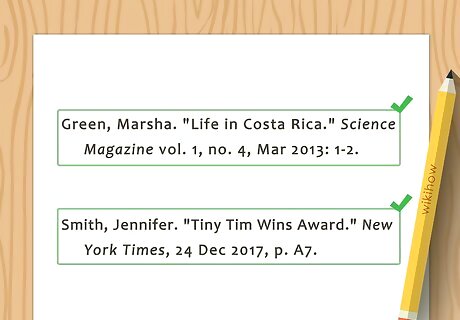
Cite articles. Start with the last name and first name of the author, followed by a period. Then the title of the article should be in quotes, with a period after the title (but still inside the last quotation mark). The name of the periodical or book should follow in italics, followed by a comma and then volume and issue numbers and date of publication, all separated by commas. Finally, a colon separates the date of publication the title of the article, the title of the publication, the volume and issue number, the date, and the pages of the source. For example, an article published in a scholarly journal might look like this: Green, Marsha. "Life in Costa Rica." Science Magazine vol. 1, no. 4, Mar 2013: 1-2. If you’re citing an article in a newspaper, you only need the name of the newspaper, followed by the date it was published, and the page number. A citation for that might look like this: Smith, Jennifer. “Tiny Tim Wins Award.” New York Times, 24 Dec 2017, p. A7.
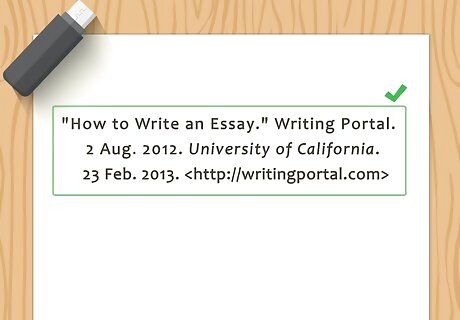
Cite websites. Start with the author's last and first name (if available) followed by a period. Then the title of the article or project in quotes, followed by the title of the website in quotes. Both titles should end in periods. Then the date of publication and the name of the sponsoring institution comes in parentheses, separated by commas. Finally, the date of access and the full web address ends the citation.
For example, a website citation might look like this: Jong, June. "How to Write an Essay." Writing Portal. 2 Aug. 2012. University of California. 23 Feb. 2013.

Use reliable sources to look for the citations rules for other types of sources. There are a lot of different types of sources you can use in a research paper. Use a reliable source to look up those citation rules. You can actually purchase a copy of the MLA style guide, or you can use a website like Purdue’s OWL (online writing lab) to look up your sources.
Writing a CMS Bibliography
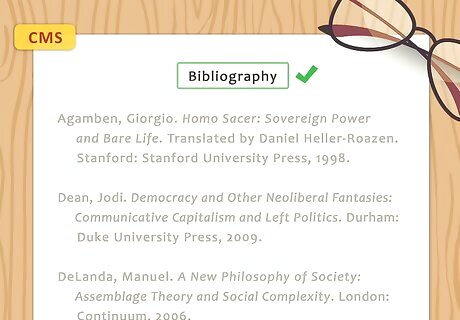
Create a bibliography page. On the first page after the end of your paper, write “Bibliography” at the top of the page. There should be two lines spaces between the title of the page and your first source.

List your sources in alphabetical order by author’s last name. Every author’s name should be listed, in the order they appear in the source. If some of your sources don’t have an author, use the first letter of the title of the source instead.

Single space your entries, with a space in between. Each source should be single-spaced, no matter how many lines the source takes up. Put one line space in between each entry.

Indent successive lines in the same source entry. If your source takes up more than one line, indent each successive line 0.5 inches (1.25 cm). Then add a line a space between the end of that entry and the next one, which should start at the original margin.
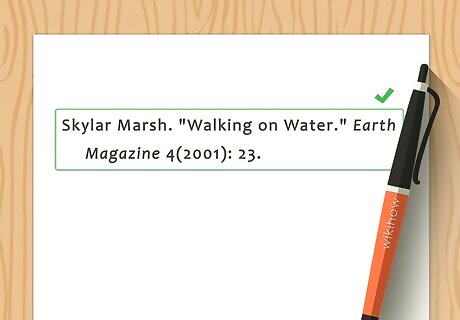
Cite articles. Start with the full name of the author, with the author’s last name first, then a comma, then the author’s first name. Then the article title should come in parentheses, with a comma at the end of the title inside the parentheses. Then the journal or magazine title should be italicized, followed by volume number, and then the issue number. The issue number should be preceded by “no.” The month and year the article was published comes next in parentheses, then a colon and the page range of the article. Example: Skylar Marsh. "Walking on Water." Earth Magazine 4(2001): 23.

Cite books. Write the full name of the author, with the author’s last name first, followed by a comma and then the author’s first name. The title of the book comes next, in italics. Then the city of publication, followed by a colon. The publisher and the publication year are then separated by a comma, and the whole citation ends with a period. For example, a book entry might look like this: Walter White. Space and Time. New York: London Press, 1982
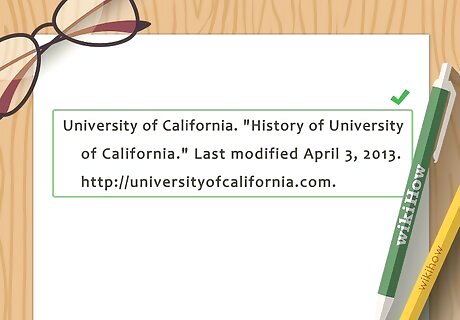
Cite websites. Write the name of the company or organization, the name of the web page or article, the date it was last modified, and the full web address. If a digital object identifier is available, use that instead of the url. Most DOIs can be found at the bottom of the webpage or at the top near the title information. Example: University of California. "History of University of California." Last modified April 3, 2013. https://universityofcalifornia.com. Unless there is a publication date for the website you’re citing, you don’t need to include an access date. If you do have an access date, it goes at the end of the citation.

















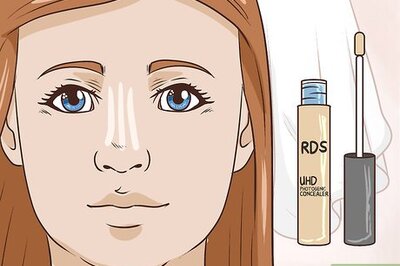


Comments
0 comment